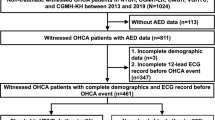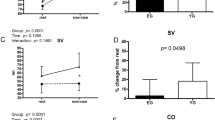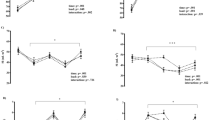Abstract
A decrease in systemic arterial compliance (SAC) increases left ventricular load along with the demand for excessive myocardial oxygen consumption when the age-related reduction of SAC reaches a marked level, and consequently may depress left ventricular pump function. Reduced left ventricular pump function decreases aerobic capacity, and some study groups have shown that SAC and/or central arterial distensibility is correlated with maximal aerobic capacity in humans. We thus hypothesize that, once the age-related reduction of SAC reaches a marked level, the participation of SAC in aerobic capacity will be significant even during sub-maximal exercise. Thirty young humans and 46 elderly humans participated in this study. SAC, oxygen uptake at the ventilatory threshold (V̇ O2 VT), and the ratio of increase in oxygen uptake, in cardiac output, and in effective arterial elastance to increase in work rate (ΔV̇ O2/ΔWR, ΔCO/ΔWR and ΔEa/ΔWR) were measured. SAC was significantly higher in young subjects compared with elderly subjects, and was significantly related to V̇ O2 VT in elderly subjects. SAC also significantly correlated with ΔV̇ O2/ΔWR, ΔCO/ΔWR and ΔEa/ΔWR in elderly subjects. When total subjects were divided by the value of SAC into 6 groups, the V̇ O2 VT values in the 3 groups with lower SAC were significantly lower than those in the 3 groups with higher SAC, and gradually decreased with the reduction of SAC. There were no changes in V̇ O2 VT among the 3 groups with higher SAC. These results suggest that the participation of SAC in aerobic capacity is significant even during sub-maximal exercise in individuals who show a pronounced age-related reduction of SAC.
Similar content being viewed by others
Article PDF
References
Safar ME, Levy BI, Laurent S, London GM : Hypertension and the arterial system: clinical and therapeutic aspects. J Hypertens Suppl 1990; 8: S113–S119.
Cameron JD, Dart AM : Exercise training increases total systemic arterial compliance in humans. Am J Physiol 1994; 266: H693–H701.
Liu Z, Brin KP, Yin FC : Estimation of total arterial compliance: an improved method and evaluation of current methods. Am J Physiol 1986; 251: H588–H600.
Tanaka H, Dinenno FA, Monahan KD, et al: Aging, habitual exercise, and dynamic arterial compliance. Circulation 2000; 102: 1270–1275.
Otsuki T, Maeda S, Kesen Y, et al: Age-related reduction of systemic arterial compliance induces excessive myocardial oxygen consumption during sub-maximal exercise. Hypertens Res 2006; 29: 65–73.
Sugawara J, Otsuki T, Maeda S, et al: Effect of arterial lumen enlargement on carotid arterial compliance in normotensive postmenopausal women. Hypertens Res 2005; 28: 323–329.
Seals DR : Habitual exercise and the age-associated decline in large artery compliance. Exerc Sport Sci Rev 2003; 31: 68–72.
Kolh P, D'Orio V, Lambermont B, et al: Increased aortic compliance maintains left ventricular performance at lower energetic cost. Eur J Cardiothorac Surg 2000; 17: 272–278.
Elzinga G, Westerhof N : Pressure and flow generated by the left ventricle against different impedances. Circ Res 1973; 32: 178–186.
Itoh H, Taniguchi K, Koike A, Doi M : Evaluation of severity of heart failure using ventilatory gas analysis. Circulation 1990; 81: II31–II37.
Ogawa T, Spina RJ, Martin WH 3rd, et al: Effects of aging, sex, and physical training on cardiovascular responses to exercise. Circulation 1992; 86: 494–503.
Seals DR, Hagberg JM, Spina RJ, et al: Enhanced left ventricular performance in endurance trained older men. Circulation 1994; 89: 198–205.
Kingwell BA, Cameron JD, Gillies KJ, Jennings GL, Dart AM : Arterial compliance may influence baroreflex function in athletes and hypertensives. Am J Physiol 1995; 268: H411–H418.
Cameron JD, Rajkumar C, Kingwell BA, Jennings GL, Dart AM : Higher systemic arterial compliance is associated with greater exercise time and lower blood pressure in a young older population. J Am Geriatr Soc 1999; 47: 653–656.
Tanaka H, DeSouza CA, Seals DR : Absence of age-related increase in central arterial stiffness in physically active women. Arterioscler Thromb Vasc Biol 1998; 18: 127–132.
Vaitkevicius PV, Fleg JL, Engel JH, et al: Effects of age and aerobic capacity on arterial stiffness in healthy adults. Circulation 1993; 88: 1456–1462.
Otsuki T, Sugawara J, Tanabe T, et al: Effects of systemic arterial compliance on cardiorespiratory fitness in elderly women—cross-sectional and longitudinal study—. J Jpn Soc Clin Sports Med 2003; 11: 543–551.
Wasserman K, Hansen JE, Sue DY, Whipp BJ : Slope of V O2 as a function of the work rate, in Wasserman K, Hansen JE, Sue DY, Whipp BJ ( eds): Principles of Exercise Testing and Interpretation. Philadelphia, Lea & Febiger, 1987, p 31.
Itoh H, Nakamura M, Ikeda C, et al: Changes in oxygen uptake-work rate relationship as a compensatory mechanism in patients with heart failure. Jpn Circ J 1992; 56: 504–508.
Gizdulich P, Prentza A, Wesseling KH : Models of brachial to finger pulse wave distortion and pressure decrement. Cardiovasc Res 1997; 33: 698–705.
Bos WJ, van Goudoever J, van Montfrans GA, van den Meiracker AH, Wesseling KH : Reconstruction of brachial artery pressure from noninvasive finger pressure measurements. Circulation 1996; 94: 1870–1875.
Imholz BP, Langewouters GJ, van Montfrans GA, et al: Feasibility of ambulatory, continuous 24-hour finger arterial pressure recording. Hypertension 1993; 21: 65–73.
Otsuki T, Sugawara J, Tanabe T, et al: Simple and noninvasive estimate of systemic arterial compliance by using peripheral arterial blood pressure waveform in elderly people. Int J Sport Health Sci 2003; 1: 136–141.
Otsuki T, Sugawara J, Tanabe T, et al: Noninvasive estimate of systemic arterial compliance by using peripheral arterial blood pressure waveform during light exercise in elderly people. Int J Sport Health Sci 2003; 1: 142–147.
Sugawara J, Tanabe T, Miyachi M, et al: Non-invasive assessment of cardiac output during exercise in healthy young humans: comparison between Modelflow method and Doppler echocardiography method. Acta Physiol Scand 2003; 179: 361–366.
Wesseling KH, Jansen JR, Settels JJ, Schreuder JJ : Computation of aortic flow from pressure in humans using a nonlinear, three-element model. J Appl Physiol 1993; 74: 2566–2573.
Beaver WL, Wasserman K, Whipp BJ : A new method for detecting anaerobic threshold by gas exchange. J Appl Physiol 1986; 60: 2020–2027.
Kelly RP, Ting CT, Yang TM, et al: Effective arterial elastance as index of arterial vascular load in humans. Circulation 1992; 86: 513–521.
Ehsani AA, Spina RJ, Peterson LR, et al: Attenuation of cardiovascular adaptations to exercise in frail octogenarians. J Appl Physiol 2003; 95: 1781–1788.
Najjar SS, Schulman SP, Gerstenblith G, et al: Age and gender affect ventricular-vascular coupling during aerobic exercise. J Am Coll Cardiol 2004; 44: 611–617.
Fleg JL, O'Connor F, Gerstenblith G, et al: Impact of age on the cardiovascular response to dynamic upright exercise in healthy men and women. J Appl Physiol 1995; 78: 890–900.
O'Rourke MF : Steady and pulsatile energy losses in the systemic circulation under normal conditions and in simulated arterial disease. Cardiovasc Res 1967; 1: 313–326.
Urschel CW, Covell JW, Sonnenblick EH, Ross J Jr, Braunwald E : Effects of decreased aortic compliance on performance of the left ventricle. Am J Physiol 1968; 214: 298–304.
Avolio AP, Chen SG, Wang RP, et al: Effects of aging on changing arterial compliance and left ventricular load in a northern Chinese urban community. Circulation 1983; 68: 50–58.
Kakiyama T, Matsuda M, Koseki S : Effect of physical activity on the distensibility of the aortic wall in healthy males. Angiology 1998; 49: 749–757.
Tomiyama H, Arai T, Koji Y, et al: The age-related increase in arterial stiffness is augmented in phases according to the severity of hypertension. Hypertens Res 2004; 27: 465–470.
Tanaka H, Kiyonaga A, Terao Y, et al: Double product response is accelerated above the blood lactate threshold. Med Sci Sports Exerc 1997; 29: 503–508.
Kakiyama T, Sugawara J, Murakami H, et al: Effects of short-term endurance training on aortic distensibility in young males. Med Sci Sports Exerc 2005; 37: 267–271.
Kakiyama T, Koda Y, Matsuda M : Effects of physical inactivity on aortic distensibility in visually impaired young men. Eur J Appl Physiol 1999; 79: 205–211.
Tanabe T, Maeda S, Sugawara J, et al: Effect of physical activity on systolic blood pressure in elderly humans—special reference to systemic arterial compliance—. Jpn J Phys Fitness Sports Med 2003; 52: 167–176.
Author information
Authors and Affiliations
Corresponding author
Rights and permissions
About this article
Cite this article
Otsuki, T., Maeda, S., Sugawara, J. et al. Age-Related Reduction of Systemic Arterial Compliance Relates to Decreased Aerobic Capacity during Sub-Maximal Exercise. Hypertens Res 29, 759–765 (2006). https://doi.org/10.1291/hypres.29.759
Received:
Accepted:
Issue date:
DOI: https://doi.org/10.1291/hypres.29.759
Keywords
This article is cited by
-
Impact of short-term training camp on arterial stiffness in endurance runners
The Journal of Physiological Sciences (2015)



